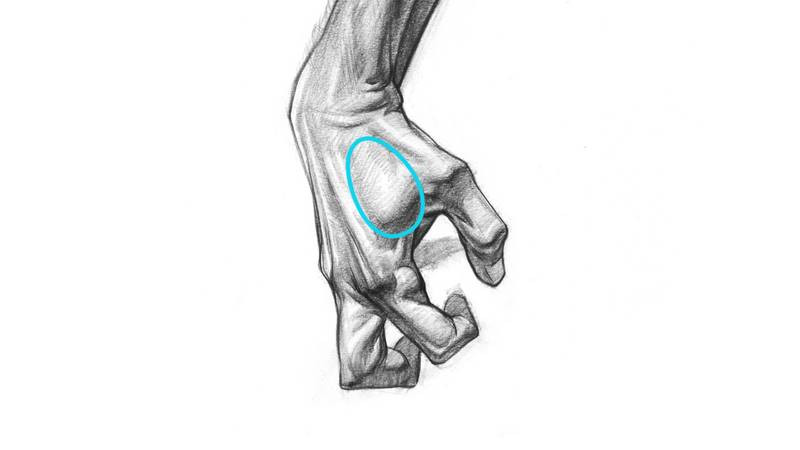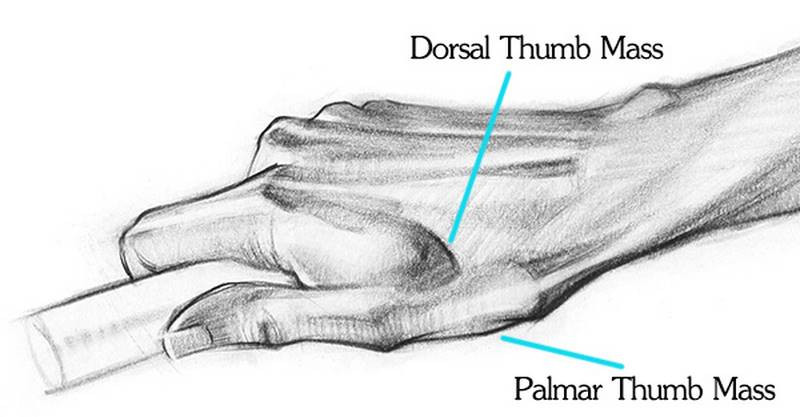I get a lot of tutorial requests, but today's topic is hands-down the most-requested. Today, we learn how to draw hands.
My previous hand lesson explained the bones. Even if you're not interested in drawing skeletons, the bones determine the proportions and range of motion. For the hand in particular, a lot of the forms of the bones are visible on the surface, so you gotta know them! If you didn't watch that lesson yet, it's here waitin' for you...

In the next few lessons, we'll cover everything else about hands. We're gonna do it in four parts. Part 1 is about the muscles of the hand and how they should inform your drawings. Then, I'll teach you how to draw the surface details of the hands, like fingernails, skin folds, and fat pads. In Part 3, I'll show you a drawing process for drawing hands from reference or from your imagination. And part 4 will be a series of step-by-step drawing demos. It's gonna be good. If you've been wanting to get better at drawing hands, clear your schedule. And tell your friends...
So, welcome to Part 1...
Muscles of the Hands
Most of the muscles that control the hand are located in the forearm. Remember those? They're called the extrinsic muscles of the hand. It means they're located on the exterior and send long tendons to control the hand. Now we'll study the intrinsic muscles of the hand. The ones located in the hand itself.
These muscles can be grouped into three teardrops: The thumb gets two teardrops and the pinky gets one on the palm side. Their teardrop-shapes are wider at the wrist and taper towards the fingers.

The one on the palm side of the thumb is the biggest. They're like the Papa Bear, Mama Bear, and Baby Bear!
But what about fingers? The fingers are made up of bones, tendons and fat... no muscle fibers in the fingers! All muscle bellies end before the metacarpophalangeal joint, (blue). That goes for the thumb, too. Remember, the thumb only has two phalanges. As you can tell from it's shape, the thumb is different from the others. There are a lot of muscles surrounding the thumb and it has a much larger range of motion.

Thenar Eminence
Let's start with the thenar eminence. That's a fancy word for the thumb mass on the palm side. It's the biggest and most important muscle mass on the palm. It emerges from the wrist and attaches along the thumb bones. It stretches out when you stick out your thumb, but even then you can see how thick it is. It's even more obvious when the thumb is brought towards the palm, and all the muscles bunch up into a big mass around the base. Papa Bear has a fat pot belly. You can think of it like a cone or a chicken drumstick on the thumb's metacarpal. It changes shape as the thumb moves, which makes it a little tricky, but as long as you know its origin and insertion, you know the area it fits into.

To fully understand it’s form, you gotta know the layering of the muscles. I’ll explain all the individual hand muscles in-depth in the Premium version of this lesson.
Hypothenar Eminence
Next up, the pinky muscle mass, technically called the hypothenar eminence. This one is long and narrow, not quite as thick or wide as the thumb mass. It may look like these two masses meet in the middle of your palm, but the muscle fibers actually stop a little short with a tendinous gap between. It's the fat sitting on top that blends them together.

Don't go overboard with the hard edge between them or you'll end up with hand-butts! In general, it's better to shade it with tone than mark it with a black outline. Unless the palm is squeezed together, bringing Papa Bear and Mama Bear in for a hug. In that case hand butts are totally acceptable.

The pinky mass starts at the base of the hand. It actually travels over the side of the hand and attaches to the outside of the pinky metacarpal. It makes this mass. This is why the ulnar side of your hand is kind of squishy when you poke it, while the radial side is hard and bony

This pinky mass has a weird muscle on top of it that's kinda unique. It runs perpendicular to the other muscles of the pinky. This muscle is called the palmaris brevis. Sound familiar? There was that palmaris longus muscles we learned in the forearm lesson that had the wide palm aponeurosis at the end of it. Well, the palmaris brevis originates on this palmar aponeurosis. It inserts on the skin along the pinky border of the palm. Ok, interesting... What does this muscle do? It pulls the skin inward and helps to improve grip. Go ahead and try it. Squeeze your hand together like you're gripping something. Notice that interesting indent it creates along the side of the hand. That's the skin being pulled. The skin and palmar fat bunch up. Under the crease you can see that large abductor digiti minimi. I bet you've seen that indent a gazillion times, but never really understood it. Now you know.
First Dorsal Interosseous
The final teardrop shape is the first dorsal interosseous. It's the Baby Bear teardrop on the dorsal side of the thumb. It creates this egg-shaped bulge between the thumb and index finger metacarpals, filling that v-shaped gap between the bones. Since it's between the two bones, the dorsal surfaces of those bones are still subcutaneous. That means you can feel the back of the bones and the soft squishy muscle between. Go ahead and find it on yourself.
When the thumb is out, this muscle mass is stretched out. Look at the overlap between this muscle, on the dorsal-ulnar side of the thumb, and the muscles and skin on the palmar side. There's a lot of depth to this area. Beginning artists often draw a simple contour and accidentally flatten it out. Instead, focus on the overlaps. Draw overlapping lines so it's clear what's in front and what's behind. It will add depth to your drawings. This is why anatomy is helpful - now you know where this mass is coming from, so you can draw it with more context.

When the thumb is squeezed in, it pops out as a big round egg form. It's not as thick as the palmar thumb mass. It's shorter, too. The dorsal thumb mass only reaches the metacarpals, while the palmar thumb mass starts way up at the wrist.
When the thumb is squeezed in, it pops out as a big round egg form. It's not as thick as the palmar thumb mass. It's shorter, too. The dorsal thumb mass only reaches the metacarpals, while the palmar thumb mass starts way up at the wrist.
So, you can see in this photo the dorsal thumb mass ends here at the metacarpal bone. The palmar thumb mass peeks out down here, much closer to the wrist.

Remember there's a lot of loose skin around this area too. When the thumb and index fingers spread, the skin is pulled tight in a straight line between the knuckles. As they come together, that line loosens into an inward curve. When they get really close together, the skin gets pinched and bunches outward.
Ok, so those are the muscles of the hand!
Assignment
It's time to get your hands dirty! Your homework is to draw hand quick-sketches. Focus on the three fleshy masses I talked about today. Your goal is to create drawings with good gesture and simple 3D form. Make sure you use a good balance of straights and curves. Identify the superficial bony areas and check to make sure your muscle forms attach to the right spots on the bones. Be sure to post your drawings in the Anatomy discussions tab, so that you can get feedback and possibly included in the critique video.





























